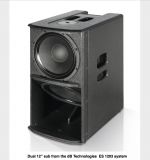I'm still on the hunt for the "perfect compromise" smallish horn sub. Obviously, some kind of TH will most likely be the answer, but I'm curious about what some companies call a "semi Horn" design. Here's a modern version from DB Technologies, using dual 12" drivers: (below)
I remember years ago that EV made a smallish single 18" like this, and it sounded really punchy. Probably not a lot of LF extension, though. Many other single-drivers subs like this have been offered over the years, though it's not super common. - But what the heck is this DB Tech design? Are both drivers loading the same space? (with some kind of high-tech DSP control?) Is it one small BR sub on top of a massively-compromised TH chamber?
I don't get it, but I'm very curious to know how, and how well, this design works.
I remember years ago that EV made a smallish single 18" like this, and it sounded really punchy. Probably not a lot of LF extension, though. Many other single-drivers subs like this have been offered over the years, though it's not super common. - But what the heck is this DB Tech design? Are both drivers loading the same space? (with some kind of high-tech DSP control?) Is it one small BR sub on top of a massively-compromised TH chamber?
I don't get it, but I'm very curious to know how, and how well, this design works.
Attachments
Last edited:
Nice find, Matt! I can't believe this guy opened it up.
But I still don't see exactly how it works. It looks more like both drivers are loaded by the top chamber,. - Except the top driver needs a port, so there must be an opening at the back-middle so the "scoop" works as a port for both drivers.
Which would then makes this really just a 2-driver BR box, no?
So then what is the purpose of angling the bottom speaker? There isn't nearly enough internal air column for this to qualify as a TH.
And yet, if this "works" for some reason, then maybe a larger version of it (still using 12" drivers) could make a decent sub?
But I still don't see exactly how it works. It looks more like both drivers are loaded by the top chamber,. - Except the top driver needs a port, so there must be an opening at the back-middle so the "scoop" works as a port for both drivers.
Which would then makes this really just a 2-driver BR box, no?
So then what is the purpose of angling the bottom speaker? There isn't nearly enough internal air column for this to qualify as a TH.
And yet, if this "works" for some reason, then maybe a larger version of it (still using 12" drivers) could make a decent sub?
Historically, truncated horns were sections out of full range expo horns with Lansing/Altec's pioneering VoTT series being 1/8 WL of the horn's Fc with a reflex back chamber tuned originally to driver Fs, though in reality they initially were parabolic due to having one pair of 'flares' parallel with just the original 800 series converted to expo a few? years later.
Nowadays they apparently design parabolic 'constant directivity' (CD) horn profiles, though haven't reverse engineered any of the ~recent designs to know for sure and WRT its Fc design, just take its acoustical pathlength to find its ~ design Fc.
Nowadays they apparently design parabolic 'constant directivity' (CD) horn profiles, though haven't reverse engineered any of the ~recent designs to know for sure and WRT its Fc design, just take its acoustical pathlength to find its ~ design Fc.
Except the top driver needs a port..........could make a decent sub?
Why? At a glance from just looking at some stills of the video it appears the top driver can be an (active) 'port', so to speak and/or the angled driver can be an offset driver compression horn and/or 'port', which to my way of thinking is basically just a fancy dual driver compound horn, ergo can potentially make an excellent wide range 'sub'.
Maybe it's angled to make it possible to fit two 12" drivers and a front vent into a box that high...So then what is the purpose of angling the bottom speaker?
The short "horn" could also provide a little gain at upper frequencies to compensate for rolloff due to driver Le.
I'd be curious enough to measure the output from the amp that's driving the angled subwoofer that's in the "horn". Maybe they're EQ'ing the signal to null out any vent resonances
Note: seeing that it starts rolling off above 60 Hz and is more than 12dB down at 50 Hz (going by that test video in post #2, I probably would not call this design a "subwoofer"...
